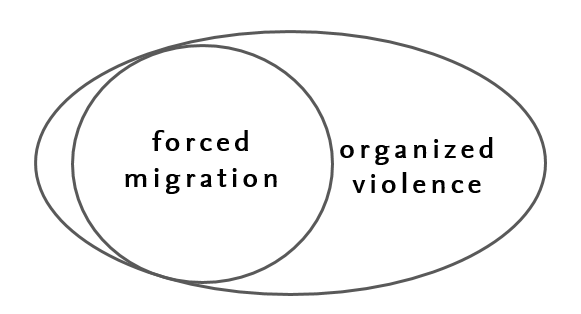Guiding Questions and Conceptual Framework
The ForMOVe research project will compare and contrast forms of forced migration in its interrelation with organized violence by analyzing biographies and trajectories. Therefore, we formulated one main guiding question and three sub questions as well as operational definitions for the concept of forced migration and for the concept of organized violence.
Guiding Questions
How are experiences and perceptions of forced migration and organized violence represented and reconstructed in actors’ migration trajectories (as sequences of persons through social positions) and biographies (as subjective reconstructions of one’s life-course)?
-
Which contexts and causes are experienced and perceived as factors for forced migration and organized violence in the trajectories and biographies of the migrants?
-
How is the role of organizations (as differentiated cooperation units with membership rules and variable goals and structures) and governance (as regulations and practices including mechanisms of control and sanctions) represented and reconstructed in actors’ migration trajectories and biographies?
-
How do migrant organizations and local state actors perceive the nexus of forced migration and organized violence as influencing migrants’ trajectories and governance structures?
Forced Migration
Internal or international spatial (and always social) mobility as collective action (families, socio-cultural-ethnic groups), iterative-sequential, long lasting, reversible, mutual influence of migrants and sedentary groups, multi-local and multi-dimensional (economic, political, social y cultural).
Forced migration can be the result of a diversity of factors: political or economic insecurity, environmental causes, forced displacement due to development projects, as victims of trafficking, exploitation and other forms of violent organizations (such as gangs and cartels). It may be carried out individually or as a collective action (families, socio-cultural-ethnic groups). It must be understood within the scope of globalization and structural inequalities (North-South) and its theorization should be linked to a deepening factor of underdevelopment.
Although all migration to a certain extent is mixed migration – our project focuses on forced and involuntary migration in its interrelation with organized violence.

Organized Violence
Organized violence refers to the use of physical perpetrated force in a collective, continuing and organized way, in order to achieve collective and/or corporate (organized) goals. In this way, it differs from collective violence because of its durability while also contrasting with organized crime insofar as it appears in both legal and illegal forms.
Organized violence also functions as an INDIRECT COERCION or as SEQUENTIAL AFTEREFFECTS on individuals and social groups: it restricts, dictates or forces people’s behaviour by either threats of direct organized violence or by perceiving/remembering organized violence that has already occurred. It breaks up communities and undermines traditional ways of life. Organized violence always is related to other types of violence like symbolic and structural violence, namely gender-based, homophobic and race/ethnic-based persecution. Social groups can deal with organized violence by exit, voice or loyalty (A.O. Hirschman), in this sense, migration is forced when it is the exit strategy of situations of direct organized violence or indirect coercion.